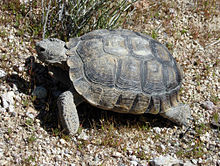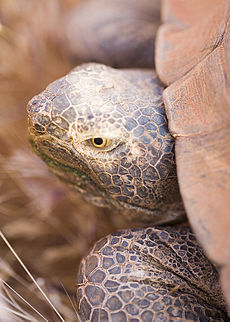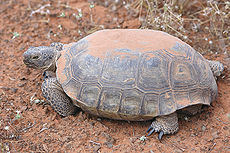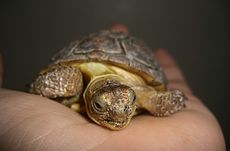- Desert tortoise
-
Desert tortoise 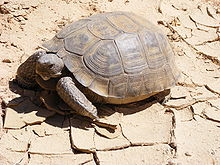
Desert tortoise, G. agassizii Conservation status Scientific classification Kingdom: Animalia Phylum: Chordata Class: Sauropsida Order: Testudines Suborder: Cryptodira Superfamily: Testudinoidea Family: Testudinidae Genus: Gopherus Species: G. agassizii Binomial name Gopherus agassizii
Cooper, 1863The desert tortoise (Gopherus agassizii) is a species of tortoise native to the Mojave desert and Sonoran desert of the southwestern United States and northwestern Mexico.[1] They can be located in the western Arizona, southeastern California, south Nevada, and the southwestern region of Utah.[1] The species name agassizii is in honor of Swiss-American zoologist Jean Louis Rodolphe Agassiz. Recently, on the basis of DNA, geographic, and behavioral differences between desert tortoises in the Sonoran and Mojave desert, it was decided that the species should be split into two separate species: the Mojave Desert Tortoise (Gopherus agassizii) and Sonoran Desert Tortoise (Gopherus morafkai). [2]
Contents
Description
This tortoise may attain a length of 10 to 14 inches (25 to 36 cm),[3] with males being slightly larger than females. Male tortoises have a longer gular horn than females, their plastron (lower shell) is concave compared to female tortoises. Males have larger tails than females do. Their shells are high-domed, and greenish-tan to dark brown in color. Desert tortoises can grow from 4–6"(10–15 cm) in height and weigh 8–15 lb (4–7 kg) when fully grown. The front limbs have sharp, claw-like scales and are flattened for digging. Back legs are skinnier and very long
Habitat
Desert tortoise in Rainbow Basin near Barstow, California.
The tortoise is able to live where ground temperature may exceed 140 degrees Fahrenheit (60 degrees Celsius) because of its ability to dig underground burrows and escape the heat. At least 95% of its life is spent in burrows. There, it is also protected from freezing winter weather while dormant, from November through February or March. With its burrow, this tortoise creates a subterranean environment that can be beneficial to other reptiles, mammals, birds and invertebrates.
Scientists have divided the desert tortoise into two types: the Mojave and Sonoran Desert tortoises, with a possible third type in the Black Mountains of northwestern Arizona.[4] They live in a different type of habitat, from sandy flats to rocky foothills. They have a strong proclivity in the Mojave desert for alluvial fans, washes and canyons where more suitable soils for den construction might be found. They range from near sea level to around 3,500 feet (1,100 m) in elevation. Tortoises show very strong site fidelity, and have well established home ranges where they know where their food, water and mineral resources are, and who their neighbors are. They also live to be 80–100 years old, although predation, disease and habitat loss have created significant challenges for the population at large.
Diet
The desert tortoise is a herbivore. Grasses form the bulk of its diet, but it also eats herbs, annual wildflowers, and new growth of cacti, as well as their fruit and flowers. Rocks and soil are also ingested, perhaps as a means of maintaining intestinal digestive bacteria as a source of supplementary calcium or other minerals. As with birds, stones may also function as gastroliths, enabling more efficient digestion of plant material in the stomach.
Much of the tortoise’s water intake comes from moisture in the grasses and wildflowers they consume in the spring. A large urinary bladder can store over forty percent of the tortoise's body weight in water, urea, uric acid and nitrogenous wastes. During very dry times they may give off waste as a white paste rather than a watery urine. During periods of adequate rainfall, they drink copiously from any pools they find, and eliminate solid urates. Adult tortoises can survive a year or more without access to water.
One defense mechanism the tortoise has when it is handled is to empty its bladder. This can leave the tortoise in a very vulnerable condition in dry areas, and they should never be alarmed, handled or picked up in the wild unless they are in imminent danger (like in a road).
Reproduction
Tortoises mate in the spring and in the fall. The female will lay a clutch of 3 - 5 hard-shelled-eggs (which are the size and shape of ping-pong balls), usually in June or July, and they hatch in August or September. Wild female tortoises can produce 2 or possibly 3 clutches a year.[5] Their eggs incubate from 90 to 135 days. Tortoises reach sexual maturity at the age of 15. With a high mortality rate, their average life expectancy is between 50 to 80 years if they survive past 20 years of age.[6]
Predation and conservation status
Ravens, gila monsters, Kit foxes, badgers, roadrunners, coyotes, and fire ants are all natural predators of the desert tortoise. They prey on eggs, juveniles, which are 2-3 inches long with a thin, delicate shell, or in some cases adults. Ravens are hypothesized to cause significant levels of juvenile tortoise predation in some areas of the Mojave Desert - frequently near urbanized areas. The most significant threats to tortoises include urbanization, disease, habitat destruction and fragmentation, illegal collection and vandalism by humans, and habitat conversion from invasive plant species (Brassica tournefortii, Bromus rubens and Erodium spp).
Desert tortoise populations in some areas have declined by as much as 90% since the 1980s and the Mojave population is listed as threatened. It is unlawful to touch, harm, harass or collect wild desert tortoises. It is, however, possible to adopt captive tortoises through the Tortoise Adoption Program (TAP) in Arizona, Utah Division of Wildlife Resources Desert Tortoise Adoption Program in Utah, in California through the Joshua Tree Tortoise Rescue Project, or through the Bureau of Land Management in Nevada. When adopted in Nevada, they will have a computer chip embedded on their back for reference. According to Arizona Game and Fish Commission Rule R12-4-407 A.1, they may be possessed if the tortoises are obtained from a captive source which is properly documented. Commission Order 43: Reptile Notes 3: one tortoise per family member.
The Fort Irwin National Training Center - the US Army recently expanded into an area that was habitat for approximately 2000 desert tortoises, and contained Critical Desert Tortoise Habitat, (a designation by the US Fish and Wildlife). In March 2008, about 650 tortoises were moved by helicopter and vehicle, up to 35 km away. This project was permitted by the US Fish and Wildlife Service. As of October 2008, 90 resident and translocated in the area have died. The second phase of the translocation project will occur in the near future, despite legal challenges filed by the Center of Biological Diversity.[7] The U.S. Army has taken extraordinary measures to protect the Desert Tortoises in the National Training Center area.
Another potential threat to the desert tortoise's habitat is a series of proposed wind and solar farms.[8] As a result of the recent legislation, solar energy companies have been making plans for huge projects in the desert regions of Arizona, California, Colorado, New Mexico, Nevada, and Utah. The requests turned in to the Bureau of Land Management total nearly 1,800,000 acres (7,300 km2). To put the scope of these projects into perspective, that is enough to cover the state of Rhode Island with solar power plants nearly three times,[9] or 2% of the area of the Sonoran and Mohave deserts.
In 2006, there was a proposal in California to build a landfill in Kern County, a site near the Desert Tortoise Natural Area (DTNA), to dump trash for Los Angeles residents. This was a threat to the tortoises. Landfill would attract tortoise’s predator, the ravens, rats, and coyotes that would threaten tortoise population.[10]
'Conservation Efforts'
The Desert Tortoise Preserve Committee (DTPC) preserve 4,340 acres of DTNA in Kern County, 710 acres in San Bernardino County, and 80 acres in Riverside County, to protect them from human invasion. The Desert Tortoise Preserve Committee preserves approximately 5,000 acres of land to protect the endangered species from human activities.[10]
Lawsuits
In the summer of 2010, Public Employees for Environmental Responsibility (PEER) filed a lawsuit against the National Park Service for not taking measure to manage gopher tortoise hunting in the Mojave National Preserve of California. Biologists discovered numerous gunshot wounds on dead turtle shells. These shells left behind by hunters attracted ravens and threatened the healthy tortoises.[11]
Diseases
Reptiles are known to become infected by a wide range of pathogens, which includes viruses, bacteria, fungi and parasites. More specifically, the desert tortoise (Gopherus agassizii) population has been negatively impacted by upper respiratory tract disease (URTD), cutaneous dyskeratosis (CD), herpes virus, shell necrosis, urolithiasis (bladder stones) and parasites (Jacobson et al. 1991, Jacobson et al. 1994, Berry et al. 2002).
Upper Respiratory Tract Disease
Upper respiratory tract disease (URTD) is a chronic, infectious disease responsible for population declines across the entire range of the desert tortoise. It was identified in the early 1970s in captive desert tortoise populations, and later identified in the wild population (Jacobson et al. 1991). URTD is caused by the infectious agents Mycoplasma agassizii and Mycoplasma testudineum, which are bacteria in the class Mollicutes and characterized by having no cell wall and a small genome (Brown et al. 1994, Berry and Van Abbema 1997, Brown et al. 1999). Mycoplasma appears to be highly virulent (infectious) in some populations, while it is chronic, or even dormant in others (USFWS 2008). The mechanism (whether environmental or genetic) that is responsible for this diversity is not understood. Infection is characterized by both physiological and behavioral changes: nasal and ocular discharge, palpebral edema (swelling of the upper and/or lower palpebra, or eyelid, the fleshy portion that is in contact with the tortoises eye globe) and conjunctivitis, weight loss, changes in color and elasticity of the integument, and lethargic or erratic behavior (Jacobson et al. 1991, Schumacher et al. 1993, Homer et al. 1998, Berry and Christopher 2001). These pathogens are likely transmitted by contact with an infected individual. Epidemiological studies of wild desert tortoises in the western Mojave Desert from 1992 to 1995 shows a 37% increase in M. agassizii (Brown et al. 1999). Tests were conducted on blood samples, and a positive test was determined by the presence of antibodies in the blood, defined as being seropositive.
Cutaneous Dyskeratosis
Cutaneous dyskeratosis (CD) is a shell disease of unknown origin and has unknown implications on desert tortoise populations. Observationally, it is typified by shell lesions on the scutes. Areas infected with CD appear discolored, dry, rough and flakey, with peeling, pitting and chipping through multiple cornified layers (Homer et al. 2001). Lesions are usually first located on the plastron (underside) of the tortoises, although lesions on the carapace (upper side) and forelimbs are not uncommon. In advanced cases, exposed areas become infected with bacteria, fungus, and exposed tissue and bone may become necrotic (Homer et al. 1998, Homer et al. 2001). CD was evident as early as 1979 and was initially identified on the Chuckwalla Bench Area of Critical Environmental Concern in Riverside County, California, USA (Jacobson 1994). Currently, the means of transmission are unknown, although hypotheses include auto-immune diseases, exposure to toxic chemicals (possibly from mines, or air pollution), or a deficiency disease (possibly resulting from tortoises consuming low-quality invasive plant species instead of high-nutrient native plants) (Jacobson et al. 1994, USFWS 2008).
Impacts of disease: Case Studies
There are two case studies outlining the spread of disease in desert tortoises. The Daggett Epidemiology of Upper Respiratory Tract Disease project, which provides supporting disease research for the Fort Irwin translocation project, lends an excellent example of the spread of disease across a landscape. In 2008, 197 health evaluations were conducted, revealing 25% - 45.2% exposure to M. agassizii and M. testudineum respectively, in a core area adjacent to interstate 15. The spread of disease was tracked over two years, and clinical signs of URTD spread from the core area to adjacent, outlying locations during this time. Overlaying home ranges and the social nature of these animals, suggests disease-free individuals may be vulnerable to spread of disease, and that transmission can occur rapidly (Mack and Berry 2009). This study suggests that wild tortoises that are close to the urban-wildlife interface may be vulnerable to spread of disease as a direct result of anthropogenic influence.
A second example outlines a study which indicates captive tortoises can be a source of disease to wild tortoise populations. Johnson et al. (2006) tested blood samples for URTD (n = 179) and herpesvirus (n = 109) from captive tortoises found near Barstow, CA and Hesperia, CA. Demographic and health data was collected from the tortoises, as well as data on other reptiles housed in the same facility. Of these, 45.3% showed signs of mild disease, 16.2% showed signs of moderate disease, and 4.5% showed signs of severe disease, and blood tests revealed that 82.7% of tortoises had anti-mycoplasma antibodies, and 26.6% had anti-herpesvirus antibodies (which means the tortoises were seropositve for these two diseases, and indicate previous exposure to the causative agents). With an estimated 200,000 captive desert tortoises in California, their escape or release into the wild is a real threat to uninfected wild populations of tortoises. Projections from this study suggest that approximately 4400 tortoises could escape from captivity in a given year, and with an 82% exposure rate to URTD, the wild population may be at greater risk than previously thought (Johnson et al. 2006).
As Pets
Before obtaining a desert tortoise as a pet it is best to check the laws and regulations of the local area and/or state. Desert tortoises may not be moved across state borders or captured from the wild. They may, however, be given as a gift from one private owner to another. Desert tortoises need to be kept outdoors in a large area of dry soil and with access to vegetation and water. An underground den and a balanced diet are crucial to the health of captive tortoises. More information on the husbandry of desert tortoises may be found here.
Management Activities and Spread of Disease
Research
Wild populations of tortoises must be managed effectively to minimize the spread of diseases, which includes research and education. Despite significant research being conducted on desert tortoises and disease, there is still a considerable knowledge gap in understanding how disease affects desert tortoise population dynamics. It is not known if the population would still decline if disease was completely absent from the system; are tortoises more susceptible to disease during draught conditions? How does non-native diet impact a tortoise’s ability to ward off pathogens? What are the causes of immunity exhibited by some desert tortoises? The 2008 USFWS draft recovery plan suggests that populations of tortoises that are uninfected, or only recently infected should likely be considered research and management priorities. Tortoises are known to show resistance to disease in some areas, an effort to identify and maintain these individuals in the populations is essential. Furthermore, increasing research on the social behavior of these animals, and garnering a greater understanding of how behavior facilitates disease transmission would be advantageous in understanding rates of transmission. Finally, translocation of tortoises should be done with extreme caution; disease is typically furtive and moving individuals or populations of tortoises across a landscape can have unforeseen consequences.
Education
Corollary to research, education campaigns are absolutely critical to prevent captive tortoises from coming in contact with wild populations, as outlined in the case study by Johnson et al. (2006). Education campaigns through veterinarians, government agencies, schools, museums and community centers throughout the range of the desert tortoise could be beneficial in limiting the spread of tortoise diseases into wild populations. Strategies may include encouraging people to not breed their captive tortoises, ensure that different species of turtles and tortoises are not housed in the same facility (which would help to prevent the spread of novel diseases into the desert tortoise population), ensure captive tortoises are adequately housed to prevent them from escaping into the wild, and to ensure that captive turtles and tortoises are never released into the wild.
In summary, desert tortoises have been severely impacted by disease. Both Upper Respiratory Tract Disease and Cutaneous Dyskeratosis have caused precipitous population declines and die-offs across the entire range of this charismatic species. Both of these diseases are extremely likely to be caused by people, and URTD is easily linked with people releasing captive tortoises into the wild. The combination of scientific research and public education are imperative to curb the spread of disease and aid the tortoise in recovery.
State reptile
The desert tortoise is the state reptile of California and Nevada.
References
- ^ a b Encyclopedia of Life,[1], "Gopherus agassizii Cooper 1863 (California) Desert Tortoise", Feb 11, 2011
- ^ US Geological Survey,[2]
- ^ Kindersley, Dorling (2001,2005). Animal. New York City: DK Publishing. ISBN 0-7894-7764-5.
- ^ "The Biogeography of The Desert Tortoise (Gopherus agassizii) ". Kerrie Bathel, San Francisco State University Dept. of Geography, Fall 2000.
- ^ blueplanetbiomes.org
- ^ Encyclopedia of Life,[3], "Gopherus agassizii Cooper 1863 (California) Desert Tortoise." Feb 11, 2011
- ^ "Army suspends relocation of Ft. Irwin tortoises". Los Angeles Times, October 11, 2008
- ^ Feinstein wants desert swath off-limits to solar, wind projects, Los Angeles Times, March 25, 2009
- ^ [4], The New York Times Company, July 13, 2009
- ^ a b Connor, Michael J., and Mark Massar, "Megadump Initiative Threat to DTNA" and "2005 Annual Report Desert Tortoise Preserve Committee Accomplishments & Activities", "Tortoise Tracks." April 2006
- ^ Stade, Kristen, "LAWSUIT TO PROTECT VARMINTS IN MOJAVE NATIONAL PRESERVE", "PEER", July 28, 2010
- Notes
- Tortoise & Freshwater Turtle Specialist Group (1996). Gopherus agassizii. 2006. IUCN Red List of Threatened Species. IUCN 2006. www.iucnredlist.org. Retrieved on 11 May 2006. Listed as Vulnerable (VU A1acde+2cde, E v2.3)
- "Gopherus agassizii". Integrated Taxonomic Information System. http://www.itis.gov/servlet/SingleRpt/SingleRpt?search_topic=TSN&search_value=173856. Retrieved 6 February 2006.
- The Desert Tortoise
- The Biogeography of The Desert Tortoise, by Kerrie Bathel
- The Arizona-Sonora Desert Museum
- Berry, K. H. and M. M. Christopher. 2001. Guidelines for the field evaluation of desert tortoise health and disease. Journal of Wildlife Diseases 37:427-450.
- Berry, K. H., E. K. Spangenberg, B. L. Homer, and E. R. Jacobson. 2002. Deaths of desert tortoises following periods of drought and research manipulation. Chelonian Conservation and Biology 4:436-448.
- Berry, K. H. and J. Van Abbema. 1997. Demographic consequences of disease in two desert tortoise populations in California, USA. Proceedings: conservation, restoration, and management of tortoises and turtles - an international conference 11–16 July 1993, State University of New York, Purchase, New York, USA.:91-99.
- Brown, M. B., K. H. Berry, I. M. Schumacher, K. A. Nagy, M. M. Christopher, and P. A. Klein. 1999. Seroepidemiology of upper respiratory tract disease in the desert tortoise in the western Mojave Desert of California. Journal of Wildlife Diseases 35:716-727.
- Brown, M. B., I. M. Schumacher, P. A. Klein, K. Harris, T. Correll, and E. R. Jacobson. 1994. Mycoplasma agassizii causes upper respiratory tract disease in the desert tortoise. Infection and Immunity 62:4580-4586.
- Homer, B. L., K. H. Berry, M. B. Brown, G. Ellis, and E. R. Jacobson. 1998. Pathology of diseases in wild desert tortoises from California. Journal of Wildlife Diseases 34:508-523.
- Homer, B. L., C. Li, K. H. Berry, N. D. Denslow, E. R. Jacobson, R. H. Sawyer, and J. E. Williams. 2001. Soluble scute proteins of healthy and ill desert tortoises (Gopherus agassizii). American Journal of Veterinary Research 62:104-110.
- Jacobson, E. R. 1994. Causes of mortality and diseases in tortoises - A review. Journal of Zoo and Wildlife Medicine 25:2-17.
- Jacobson, E. R., J. M. Gaskin, M. B. Brown, R. K. Harris, C. H. Gardiner, J. L. Lapointe, H. P. Adams, and C. Reggiardo. 1991. Chronic upper respiratory tract disease of free ranging desert tortoises (Xerobates agassizii) Journal of Wildlife Diseases 27:296-316.
- Jacobson, E. R., T. J. Wronski, J. Schumacher, C. Reggiardo, and K. H. Berry. 1994. Cutaneous dyskeratosis in free ranging desert tortoises, Gopherus agassizii, in the Colorado Desert of Southern California. Journal of Zoo and Wildlife Medicine 25:68-81.
- Johnson, A. J., D. J. Morafka, and E. R. Jacobson. 2006. Seroprevalence of Mycoplasma agassizii and tortoise herpesvirus in captive desert tortoises (Gopherus agassizii) from the Greater Barstow Area, Mojave Desert, California. Journal of Arid Environments 67:192-201.
- Mack, J. and K. H. Berry. 2009. Development of an epidemiological model of upper respiratory tract disease (Mysoplasmosis) in desert tortoises using the Daggett study area: Year 2, 2008. Proceedings of the thirty-fourth annual meeting and symposium. The desert tortoise council.
- Schumacher, I. M., M. B. Brown, E. R. Jacobson, B. R. Collins, and P. A. Klein. 1993. Detection of antibodies to a pathogenic mycoplasma in desert tortoises (Gopherus agassizii) with upper respiratory tract disease Journal of Clinical Microbiology 31:1454-1460.
- USFWS. 2008. Draft revised recovery plan for the Mojave population of the desert tortoise (Gopherus agassizii). U.S. Fish and Wildlife Service, California and Nevada Region, Sacramento, California. 209 pp.
External links
- Desert Tortoise, National Park Service
- Desert Tortoise data and information portal, Mojave Desert Ecosystem Program
- Desert Tortoise Recovery Office, Nevada Fish & Wildlife Office
Tortoise family of turtles (Testudinidae) Genus Species of the Tortoise family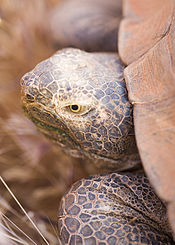
Aldabrachelys Astrochelys Angonoka tortoise · Radiated tortoiseChelonoidis Chersina Cylindraspis† Geochelone Gopherus Homopus Beaked cape tortoise · Berger's cape tortoise · Boulenger's cape tortoise · Karoo cape tortoise · Speckled padloper tortoiseIndotestudo Elongated tortoise · Forsten's tortoise · Travancore tortoiseKinixys Bell's hinge-back tortoise · Forest hinge-back tortoise · Home's hinge-back tortoise · Lobatse hinge-back tortoise · Natal hinge-back tortoise · Speke's hinge-back tortoiseMalacochersus Manouria Psammobates Pyxis Stigmochelys Testudo Phylogenetic arrangement of turtles based on turtles of the world 2010 update: annotated checklist of taxonomy, synonymy, distribution and conservation status. Key: †=extinct. 1=classification unclear Order Testudines (turtles) Kingdom: Animalia · Phylum: Chordata · Class: Reptilia · Subclass: Anapsida · Order: Testudines Suborder SuperfamilySubfamily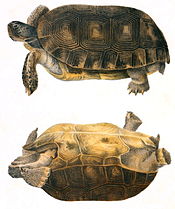
Cryptodira Chelydra · MacrochelysCaretta · Chelonia · Eretmochelys · Lepidochelys · NatatorDermochelysDermatemydidaeDermatemysStaurotypinaeClaudius · StaurotypusBatagur · Cuora · Cyclemys · Geoclemys · Geoemyda · Hardella · Heosemys · Leucocephalon · Malayemys · Mauremys · Melanochelys · Morenia · Notochelys · Orlitia · Pangshura · Rhinoclemmys · Sacalia · Siebenrockiella · VijayachelysAldabrachelys · Astrochelys · Chelonoidis · Chersina · Cylindraspis · Geochelone · Gopherus · Homopus · Indotestudo · Kinixys · Malacochersus · Manouria · Psammobates · Pyxis · Stigmochelys · TestudoTrionychiaCarettochelyidaeCarettochelysTrionychinaePleurodira ChelidinaeChelodininaeHydromedusinaePelomedusa · PelusiosPhylogenetic arrangement based on turtles of the world 2010 update: annotated checklist. Extinct turtles not included.
See also List of Testudines families
 Portal ·
Portal ·  WikiProjectCategories:
WikiProjectCategories:- IUCN Red List vulnerable species
- Gopherus
- North American desert fauna
- Indicator species of North America
- Reptiles of Mexico
- Reptiles of the United States
- Fauna of the Mojave Desert
- Fauna of the Colorado Desert
- Fauna of the Sonoran Desert
- Fauna of the Lower Colorado River Valley
- Fauna of Northern Mexico
- Symbols of California
- Natural history of the Mojave Desert
- Vulnerable fauna of California
- Vulnerable fauna of the United States
Wikimedia Foundation. 2010.


